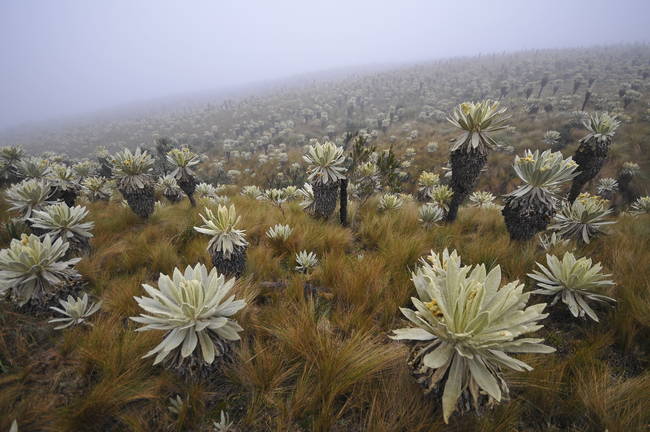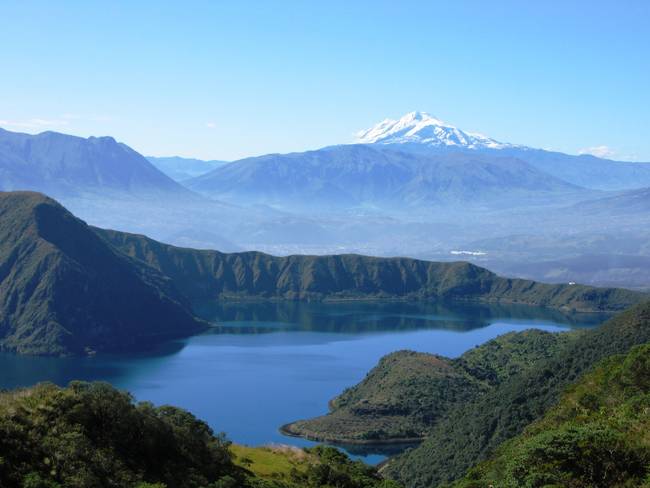The Northern Andes of Ecuador are known for their magical landscapes, unique natural attractions, and rich cultural heritage. In the northern Andes, we can find very diverse natural jewels, dry Andean forests that contrast with the humid vegetation of the highlands, a myriad of lakes, beautiful volcanoes and fertile valleys. The magical North of Ecuador is also home to many indigenous communities – like the famous Otavalos – and has the biggest Afro-American population in the country. This region is the most visited of the Andes and includes highlights like a visit to the Otavalo Indigenous market and Cuicocha Lake, known as the place of the gods. Lose yourself in the colors and textures of the handicraft market, explore millenary forests, learn the secrets of the handmade textiles and Andean instruments or share an evening by the chimney fire while listening to old legends and folktales. The North of Ecuador is the perfect destination for an authentic cultural and nature trip.
From Quito
Quito
From 3 to 4 days
A spectacular lodge in the middle of a magical forest. It´s located in an ecological reserve that protects the living species of the Andean forest.
This idyllic paradise boasts a magical desert climate and a landscape dominated by unique trees that creates an almost mystical environment.
Hotel Otavalo was the oldest hotel within the city. Now, it has been refurbished to catapult the status of the hotel and reflect the highest luxury standards.

A spectacular lodge in the middle of a magical forest. It´s located in an ecological reserve that protects the living species of the Andean forest.

This idyllic paradise boasts a magical desert climate and a landscape dominated by unique trees that creates an almost mystical environment.

Hotel Otavalo was the oldest hotel within the city. Now, it has been refurbished to catapult the status of the hotel and reflect the highest luxury standards.
*The selected hotels are subject to availability at time of booking the tour. In case of unavailability, we will offer a hotel of the same caliber.



* Tours and itineraries suggested by Bespoke Galapagos in order to have a functional trip.
** Excursions may change due to climate conditions.




* Tours and itineraries suggested by Bespoke Galapagos in order to have a functional trip.
** Excursions may change due to climate conditions.




* Tours and itineraries suggested by Bespoke Galapagos in order to have a functional trip.
** Excursions may change due to climate conditions.

QUITSATO is a sundial located near the town of Cayambe at latitude 0. This independent, non-profit project was inaugurated in 2007 and is dedicated to sharing crucial aspects of the astronomical knowledge of the pre-Hispanic cultures of the region.

Otavalo is the largest and most important indigenous market in all of Latin America. The colorful main handicraft and textile market spill into the streets from the central Plaza de Ponchos while the cacophony of the animal market is kept to the outskirts of town. The impressive produce market teems with an abundance of colorful, locally-cultivated fruits and vegetables. The friendly Otavaleños are more than happy to talk about their crafts and traditions, and will expect you to haggle prices a bit.

Peguche is a small town where we will visit a textile and handicraft workshop and learn from the owners the ancient techniques and secrets used in the making of these wonderful pieces; an example of this is the use of insects for dyeing wool. In this town, we will also stop by an Andean musical instrument workshop where musicians/instrument craftsmen will do a short performance for us.

The Liberty Train offers a unique journey on rails to the valley of Salinas de Ibarra. The train takes us to the Afro-Ecuadorian community in Salinas, passing through dry Andean forests, overhanging bridges, along with a precipice and through mountainside tunnels. The vegetation gives way to vast sugar cane fields and, further down, to cotton plantations. In Salinas, we will be welcomed by traditional songs and invited to visit the Community Center.

Parque Cóndor is a conservation project dedicated to the rescue and reintroduction of birds of prey (e.g. condors, vultures, owls) in their natural habitat. The project was funded and supported by many international zoos and organizations, who have also donated birds of different species found in the park. The visit includes a falconry show and a complete explanation of the project’s conservation efforts.

Cuicocha – meaning “place of the gods” – Lake located in inside a crater at the Cotacachi-Cayapas Ecological Reserve, located at the foothills of the still-active Cotacachi Volcano. We will do a short hike around the lagoon and enjoy a box lunch on this beautiful landscape.

This beautiful Chilean Myrtle forest has a great botanical importance, as there are only two of its kind still standing in the South American continent – one in Ecuador, and one in Bariloche, Argentina. Originating in the Pleistocene era, Ecuador’s Arrayanes forest’s importance has been recognized on a national level and is now protected by the Ecuadorian State. It utilizes over 16 hectares of soils enriched by the surrounding area’s aqueous ecosystem and minerals found in the volcanic materials that – thanks to the successive eruptions of nearby volcanoes – blanketed most of the Ecuadorian Andes. The forest has been preserved by nearby communities, especially the town of Montufar who are particularly proud of this natural jewel.

The Bolivar Paleontological Museum has over 205 fossils found in 1987 by Italian researchers Giovanni Ficarelli and Vitorio Borselli. The research performed on the fossils – estimated to be 20 million years old – determined that mastodons, saber-toothed tigers, mylodons, and wild horses inhabited this region in the Quaternary Period.

This spot is a beautiful natural cave transformed into a shrine devoted to Our Lady of Peace. This unique and impressive “church” is located in the gorge of the Apaquí River, near the community of La Paz and it is an important pilgrimage destination for both Colombian and Ecuadorian Catholics.

The site, with a remarkable view of surrounding volcanoes, is thought to have served military and astrological purposes. The Caranqui culture built this complex consisting of 15 different-sized pyramids, constructed with access ramps, as well as many
burial mounds scattered in the area. The material used in the constructions is volcanic soil, known locally as “cangahua.” Since this material is not as hard as rock or wood, the indigenous builders covered the pyramids with regular
soil and plants to avoid erosion of from the wind and rain of these slopes. Another theory hypothesizes the pyramids were covered with soil and plants to prevent detection from a distance. Most of the pyramids are still covered,
but the many archeological teams that have worked on this site have uncovered some sections where is possible to see the materials and techniques used in the construction. The teams have also dug up many instruments used by the
Caranqui people that are now in the on-site museum, which is also included in the visit.
Investigators have yet to determine these pyramids’ exact purpose; however, some of the pyramids still retain
their moon and sun calendars, which hints at an astronomical or astrological function.